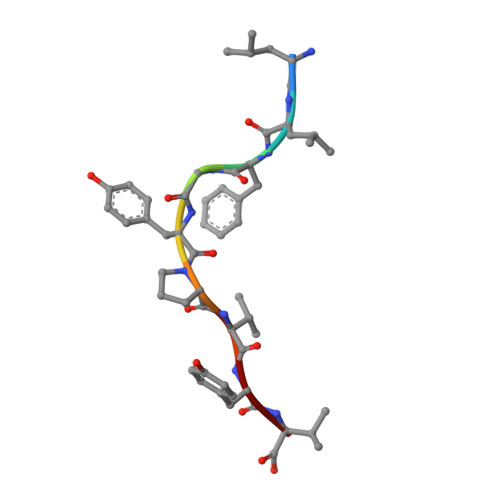Unraveling a Hotspot for TCR Recognition on HLA-A2: Evidence Against the Existence of Peptide-independent TCR Binding Determinants.
Gagnon, S.J., Borbulevych, O.Y., Davis-Harrison, R.L., Baxter, T.K., Clemens, J.R., Armstrong, K.M., Turner, R.V., Damirjian, M., Biddison, W.E., Baker, B.M.(2005) J Mol Biol 353: 556-573
- PubMed: 16197958
- DOI: https://doi.org/10.1016/j.jmb.2005.08.024
- Primary Citation of Related Structures:
2AV1, 2AV7 - PubMed Abstract:
T cell receptor (TCR) recognition of peptide takes place in the context of the major histocompatibility complex (MHC) molecule, which accounts for approximately two-thirds of the peptide/MHC buried surface. Using the class I MHC HLA-A2 and a large panel of mutants, we have previously shown that surface mutations that disrupt TCR recognition vary with the identity of the peptide. The single exception is Lys66 on the HLA-A2 alpha1 helix, which when mutated to alanine disrupts recognition for 93% of over 250 different T cell clones or lines, independent of which peptide is bound. Thus, Lys66 could serve as a peptide-independent TCR binding determinant. Here, we have examined the role of Lys66 in TCR recognition of HLA-A2 in detail. The structure of a peptide/HLA-A2 molecule with the K66A mutation indicates that although the mutation induces no major structural changes, it results in the exposure of a negatively charged glutamate (Glu63) underneath Lys66. Concurrent replacement of Glu63 with glutamine restores TCR binding and function for T cells specific for five different peptides presented by HLA-A2. Thus, the positive charge on Lys66 does not serve to guide all TCRs onto the HLA-A2 molecule in a manner required for productive signaling. Furthermore, electrostatic calculations indicate that Lys66 does not contribute to the stability of two TCR-peptide/HLA-A2 complexes. Our findings are consistent with the notion that each TCR arrives at a unique solution of how to bind a peptide/MHC, most strongly influenced by the chemical and structural features of the bound peptide. This would not rule out an intrinsic affinity of TCRs for MHC molecules achieved through multiple weak interactions, but for HLA-A2 the collective mutational data place limits on the role of any single MHC amino acid side-chain in driving TCR binding in a peptide-independent fashion.
Organizational Affiliation:
Molecular Immunology Section, Neuroimmunology Branch, National Institute of Neurological Diseases and Stroke, National Institutes of Health, Bethesda, MD 20892, USA.


















